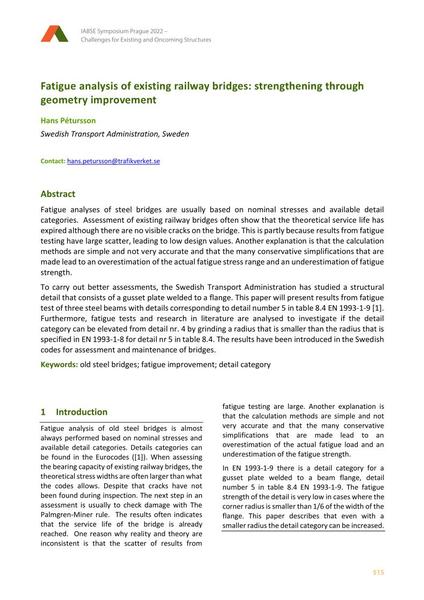Fatigue analysis of existing railway bridges: strengthening through geometry improvement

|
|
|||||||||||
Détails bibliographiques
| Auteur(s): |
Hans Pétursson
(Swedish Transport Administration, Sweden)
|
||||
|---|---|---|---|---|---|
| Médium: | papier de conférence | ||||
| Langue(s): | anglais | ||||
| Conférence: | IABSE Symposium: Challenges for Existing and Oncoming Structures, Prague, Czech Republic, 25-27 May 2022 | ||||
| Publié dans: | IABSE Symposium Prague 2022 | ||||
|
|||||
| Page(s): | 515-523 | ||||
| Nombre total de pages (du PDF): | 9 | ||||
| DOI: | 10.2749/prague.2022.0515 | ||||
| Abstrait: |
Fatigue analyses of steel bridges are usually based on nominal stresses and available detail categories. Assessment of existing railway bridges often show that the theoretical service life has expired although there are no visible cracks on the bridge. This is partly because results from fatigue testing have large scatter, leading to low design values. Another explanation is that the calculation methods are simple and not very accurate and that the many conservative simplifications that are made lead to an overestimation of the actual fatigue stress range and an underestimation of fatigue strength. To carry out better assessments, the Swedish Transport Administration has studied a structural detail that consists of a gusset plate welded to a flange. This paper will present results from fatigue test of three steel beams with details corresponding to detail number 5 in table 8.4 EN 1993-1-9 [1]. Furthermore, fatigue tests and research in literature are analysed to investigate if the detail category can be elevated from detail nr. 4 by grinding a radius that is smaller than the radius that is specified in EN 1993-1-8 for detail nr 5 in table 8.4. The results have been introduced in the Swedish codes for assessment and maintenance of bridges. |
||||
| Copyright: | © 2022 International Association for Bridge and Structural Engineering (IABSE) | ||||
| License: | Cette oeuvre ne peut être utilisée sans la permission de l'auteur ou détenteur des droits. |
||||
